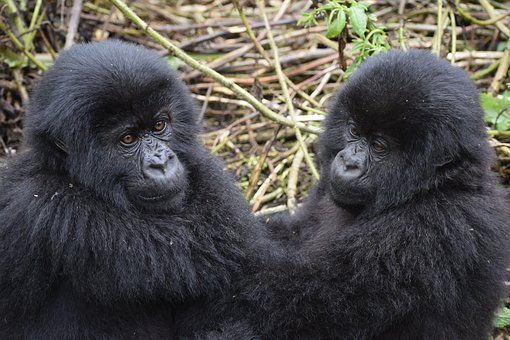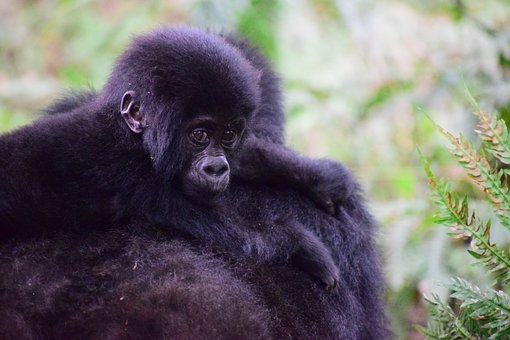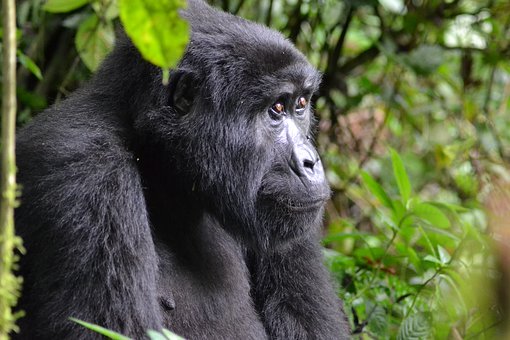Enjoy
your Africa holiday vacation with Uganda's Gentle Giants, the Gorillas
of Uganda by Twinomugisha Charles
It is estimated that there are
less than 800 of these Gorillas' in the wild. And half of these giants
are in Uganda. Uganda has more 400 Gorillas that live in the Bwindi Impenetrable
Forest National Park in south west Uganda and about 460 inhabit the Virunga
mountains of Rwanda and Congo (Zaire). It is believed that none of these
giants are to be found in captivity.
The future of these giants
is still very uncertain with the threat of poaching, habitat encroachment
by humans and regional instability constantly hanging over them.

So if you are planning to
see these magical creatures outside of history books and photographs, there
is no time like the present, because soon they may be gone forever……….Just
joking the neighboring countries are now stable and these giants have enough
peace of mind to move from Uganda to Rwanda and Congo then back to Uganda.
All the participants who have ever been to these giants agree that it is
undoubtedly one of the best wildlife experiences that they have gone through.
Apart from these giants,
there are also three other Uganda safari wildlife areas that are well worth
your time to visit: Queen Elizabeth National Park for its unique resident
tree climbing lions never to be found anywhere in the world and its bird
life. And the good thing is that there are neighbours together with Mt.
Rwenzori national park, where you can experience the most breathtaking
action in mountaineering.
By following these rules
and through the purchase of the permit, YOU too are contributing to the
conservation of the mountain gorilla. Uganda Wildlife Authority uses the
funds generated from the sale of this permit for the management of the
National Parks.
A percentage of the funds
raised from Park entrance fees are also donated to local communities living
adjacent to the parks to contribute to their development and improve natural
resource management in the region. Before departing on your giants
trek, always wash your hands before you head out to the tracking.

On the way to the gorillas:
a) A maximum number of 6
visitors (8 in DR Congo and if trekking one of the larger groups in Rwanda)
may visit a group of habituated ones in a day. This minimizes behavioral
disturbance to the gorillas and the risk of their exposure to human-borne
diseases.
b) Please always keep your
voices low. You will then also be able to observe the great bird life and
other wildlife in the forest.
c) Do not leave rubbish in
the park. Whatever you bring into the forest should be carried back out
with you.
d) You will be taken to where
the guides observed them the day before. From there you will follow their
trail to find them. Look out for the gorilla's nesting sites along the
way!
e) When you approach them,
the guides will inform you to get ready.

When you are with the
gorillas:
a) A 5 meter distance should
try to be observed at all times (15 feet) from them. This is to protect
them from catching human diseases.
b) You must stay in tight
group whey you are near them .
c) Keep your voices down
at all times. However, it is OK to ask the guide questions.
d) Do not eat or drink while
you are near them. Eating or drinking inevitably will increase the risk
of food/drink morsels/droplets falling, which could increase the risk of
transmission of diseases. e) Sometimes they charge. Follow the guides example
(crouch down slowly, do not look at them directly in the eyes and wait
for the animals to pass). Do not try and take pictures and do not attempt
to run away. Running away will increase the risk.
f) Flash photography is not
permitted! When taking pictures move, slowly and carefully.
g) Do not touch them. They
are wild animals. They might look cuddly but!!.
h) The maximum time you can
spend with them is one hour. However, if they become agitated or nervous,
the guide will finish the visit early.
i) After the visit keep your
voices down until you are 200 metres from them.
General Health Rules:
The following are ways to
minimize the risk your visit might poses to our gentle giants:
a) Remember they are very
susceptible to human diseases.
b) Respect the limits imposed
on the number of visitors allowed with the gorillas each day. This minimizes
the risk of disease transmission and stress to the group.
c) If you are feeling ill,
or you are carrying a contagious disease, volunteer to stay behind. An
alternate visit will be arranged for you, or you will be refunded your
money.
d) If you feel the urge to
cough or sneeze when you are near the gorillas, please turn your head away
and cover your nose and mouth in order to minimize the spread of bacteria
or viruses. e) Always stay 5 metres (15 feet) away form the gorillas. The
further back you are, the more relaxed the group will be.
f) Do not attempt to touch
them.
g) Do not smoke, drink or
eat when you are with these giants.
h) Do not leave any rubbish
(eg. food wrappers) in the Park; foreign items can harbor diseases or other
contaminants.
i) If you need to defecate,
whilst in the forest, please ask the guide to dig you a hole with his panga.
Make sure the hole is 30cms deep and fill it in when you are finished.
Top
|



